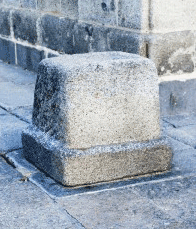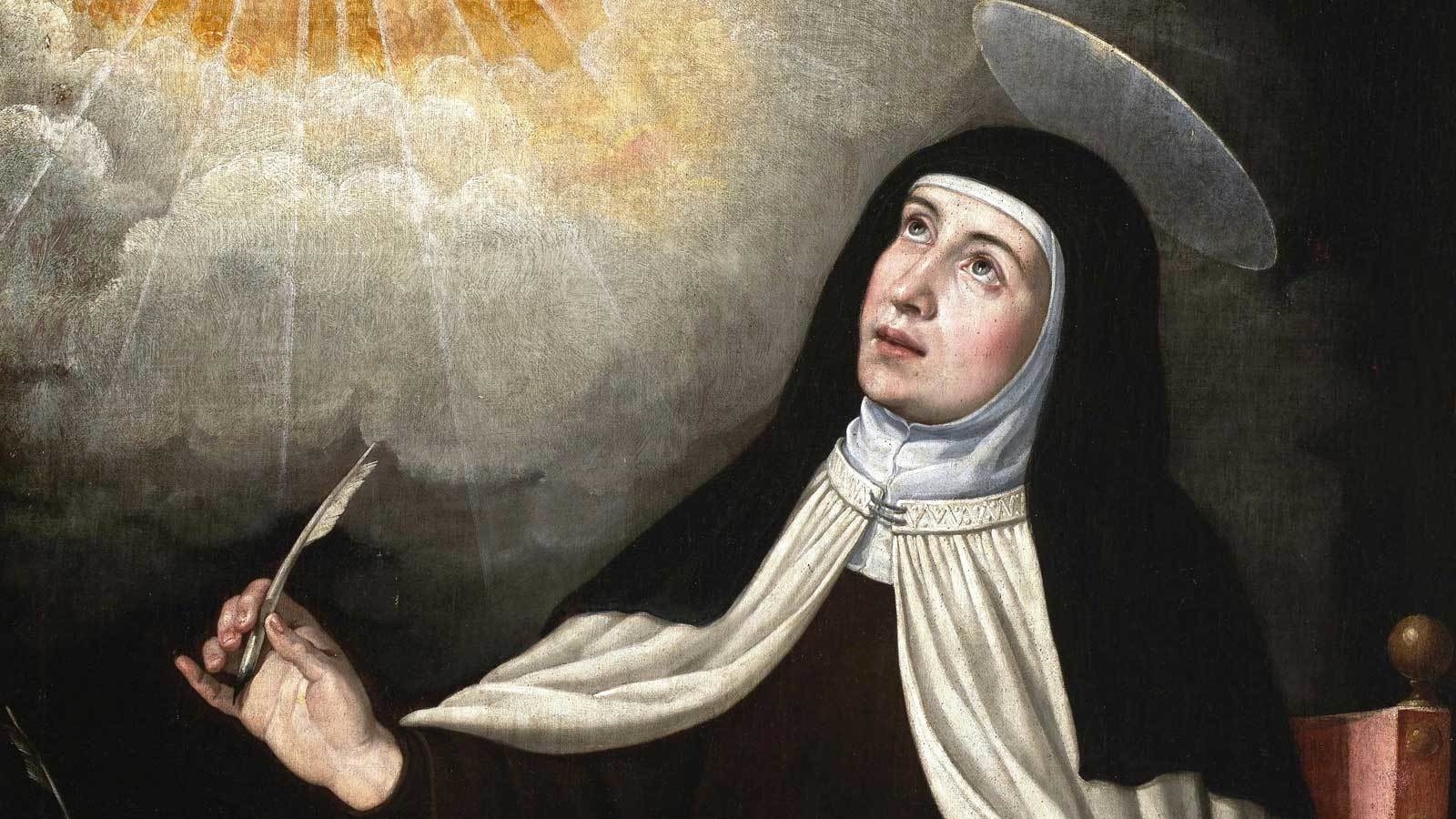
TOPICS:
Saint Teresa of Avila
Jul 22, 2013 / Written by: America Needs Fatima
Feast October 15
The Big Flower
Teresa Sanchez Cepeda Davila y Ahumada
Born at Avila, Old Castile, 28 March, 1515
Died at Alba de Tormes, 4 October, 1582
Born the third child of Don Alonso Sanchez de Cepeda by his second wife, Doña Beatriz Davila y Ahumada, Teresa was brought up by her saintly father, who was a lover of serious books, and her tender and pious mother.
When just fourteen years old, Teresa suffered the loss of her dear mother. Shortly after, her eldest sister married and Teresa was sent for her education to the Augustinian nuns at Avila. Becoming quite ill, she left a year and a half later, and for some years remained with her father and occasionally with other relatives. One such relative, an uncle, introduced her to the Letters of St. Jerome, which strongly influenced her decision to adopt the religious life, not so much through any attraction toward it, but through a desire to take the “safest” course to salvation.
Print a St. Teresa Reflections Card — 5x3 or 8x10
Entering the Carmelite Convent
Unable to obtain her father’s consent to become a religious, she left his house unknown to him in November of 1535, intent on entering the Carmelite Convent of the Incarnation at Avila. At that time the convent was home to 140 nuns.

The willful break from her family caused Teresa a pain which she ever afterwards compared to that of death. However, her father eventually yielded and Teresa took the habit.
After her profession in the following year she became very seriously ill. Her treatment was so prolonged and ineffective that she was reduced to being an invalid. She prayed incessantly to St. Joseph whose intercession brought her a partial recovery, her health remaining permanently impaired.
During these years of suffering she began the practice of mental prayer. Unfortunately, she discontinued this practice out of fear that her conversations with some worldly-minded relatives, who were frequent visitors at the convent, rendered her unworthy of the graces God bestowed on her. After receiving spiritual direction from first Dominicans, and afterwards the Jesuits, she resumed this pious practice, confirmed in the belief that it was God’s desire that she do so.
Visions and Locutions
Meanwhile, God had begun to visit her with intellectual visions and locutions, that is manifestations in which the exterior senses were in no way affected, the things seen and the words heard being directly impressed upon her mind, and giving her wonderful strength in trials, reprimanding her for unfaithfulness, and consoling her in trouble.

Unable to reconcile such graces with her shortcomings, which her delicate conscience represented as grievous faults, she often sought out the advice of the most spiritual confessors she could find, as well as some saintly laymen. Never suspecting that the account she gave them of her sins was greatly exaggerated, these confessors told her that these graces were actually the work of the evil spirit.
The more she endeavored to resist these gifts from God, the more powerfully did He work in her soul. The whole city of Avila was troubled by the reports of the visions of this nun. At long last God sent deeply devout advisors, namely St. Francis Borgia and St. Peter of Alcantara, and afterwards a number of Dominicans (particularly Pedro Ibañez and Domingo Bañez), Jesuits, and other religious and secular priests, to discern the work of God and to guide Teresa correctly in her vocation.
Spiritual Life
Several volumes were written by Teresa which give an account of her spiritual life. These works include The Way of Perfection and The Interior Castle. She also left an autobiography, The Life of St. Teresa of Ávila (completed in 1565), one of the most remarkable spiritual biographies with which only the Confessions of St. Augustine can bear comparison.

During this period Teresa experienced such extraordinary spiritual gifts as the piercing or transverberation of her heart, the spiritual espousals, and the mystical marriage.
One of the most life-altering experiences was a vision of the place reserved for her in hell should she choose not to correspond to grace. After this, the saint determined to seek a more perfect life.
In 1558 Teresa began to consider the restoration of Carmelite life to its original observance of austerity, which had relaxed in the 14th and 15th centuries. Her reform required utter withdrawal so that the nuns could meditate on divine law and, through a prayerful life of penance, exercise what she termed “our vocation of reparation” for the sins of humankind.
After many troubles and much opposition, she founded the convent of Discalced Carmelite Nuns of the Primitive Rule of St. Joseph at Avila (August 24, 1562), and after six months obtained permission to take up her residence there.
Four years later she received the visit of the General of the Carmelites, John-Baptist Rubeo (Rossi), who not only approved of what she had done but granted leave for the foundation of other convents of friars as well as nuns.
The Growth of the Discalced Carmelite Order
In rapid succession Teresa established her nuns at Medina del Campo (1567), Malagon and Valladolid (1568), Toledo and Pastrana (1569), Salamanca (1570), Alba de Tormes (1571), Segovia (1574), Veas and Seville (1575), and Caravaca (1576).
In the Book of the Foundations she tells the story of these convents, nearly all of which were established in spite of violent opposition and only through Divine assistance from above.

Everywhere she found souls generous enough to embrace the austerities of the primitive rule of Carmel. Having made the acquaintance of Antonio de Heredia, prior of Medina, and St. John of the Cross, she established her reform among the friars, the first convents being those of Duruelo (1568), Pastrana (1569), Mancera, and Alcalá de Henares (1570).
A new epoch began with the entrance into religion of Jerome Gratian, inasmuch as this remarkable man was almost immediately entrusted by the nuncio with the authority of visitor Apostolic of the Carmelite friars and nuns of the old observance in Andalusia, and as such considered himself entitled to overrule the various restrictions insisted upon by the general and the general chapter.
On the death of the nuncio and the arrival of his successor, a fearful storm burst over St. Teresa and her work, lasting four years and threatening to annihilate the nascent reform. The incidents of this persecution are best described in her letters.
The storm at length passed, and the province of Discalced Carmelites, with the support of Philip II, King of Spain, was approved and canonically established on June 22, 1580.
St. Teresa, old and broken in health, made further foundations at Villnuava de la Jara and Palencia (1580), Soria (1581), Granada (through her assistant, the Venerable Anne of Jesus), and at Burgos (1582).
Death of Saint Teresa
She left this latter place at the end of July, and, stopping at Palencia, Valldolid, and Medina del Campo, reached Alba de Torres in September, suffering intensely. Soon she took to her bed and passed away on October 15, 1582.

Shortly before St. Teresa's death, Ana de San Bartolome saw Our Lord at the foot of St. Teresa's bed in majesty and splendor, attended by myriad angels, and at the head, The Ten Thousand Martyrs who had promised St. Teresa, in a rapture experienced years before, to come for her in the moment of death. When she sighed her last breath, one of the sisters saw something like a white dove pass from her mouth.
And while Sister Catalina de la Concepcion, who was very holy and had a less than a year to live, was sitting by the low window opening on the cloister by La Madre's (the nuns’ affectionate name for St. Teresa) cell, she heard a great noise as of a throng of joyful and hilarious people making merry; and then saw innumerable resplendent people, all dressed in white, pass the cloister and enter the room of the dying Saint, where the nuns gathered about her seemed but a handful in comparison; and then all advanced toward the bed.
And this was the moment St. Teresa died.
The Legacy of the Big Flower
After some years her body was transferred to Avila, but later on returned to Alba, where it is still preserved incorrupt. Her heart, too, showing the marks of the transverberation, is exposed there to the veneration of the faithful. She was beatified in 1614, and canonized in 1622 by Gregory XV, the feast being fixed on October 15.

St. Teresa’s position among writers on mystical theology is unique. In all of her writings on this subject she deals with her personal experiences, which her deep insight and analytical gifts enabled her to explain clearly. Her style is intensely personal, her system going exactly as far as her experiences, but not a step further.
The Thomistic foundations of her spirituality may be traced to the influence of her confessors and directors, many of whom belonged to the Dominican Order.
The writings of St. Teresa of Avila comprise one holy woman’s testimony to the reality of mystical experience and a timeless affirmation of the ultimate triumph of good over evil. Her discalced Order remains to this day a vibrant example of the joy that can be found in austerity and a life lived for God alone.
Print a St. Teresa Reflections Card — 5x3 or 8x10
Images of Avila, Spain today!








Image Captions from article:
Image 1: This is the only portrait of St. Teresa, which day after day, she obediently sat for as a penance. It was painted when St. Teresa was 61, by Friar Juan de la Miseria in 1576. When the picture was finished, with a faint smile, she said: "God forgive you Fray Juan! To think that after all I have suffered at your hands, you should paint me so bleary eyed and ugly!"
Image 2: This is the stone that St. Teresa sat on, waiting for King Philip II. This stone generally goes unnoticed, it is on the front left corner of El Escorial.
Image 3: Her incorrupt body, which is above the main altar, in Alba de Tormes. Despite all her illness, which she endured her entire life, the body of St. Teresa, remains as white and smooth as alabaster, like that of a 3 year old child. All the wrinkles that had gathered since her illness have vanished. A sweet smell which nobody could describe or identify came from the body and everything that had touched it - towels, garments, even St. Teresa's finger prints on a plate. It became so overpowering in the cell where she died that the windows had to be opened to prevent headaches and fainting.
Image 4: The hourglass, spoon, and various dishes that were used by St. Teresa. St Teresa was especially fond of a gospel story of the Samaritan woman at the well seeking the water of life and she would say to Him over and over again, "Lord, give me that water!" To her water always seemed something delightful and marvelous, something at once so natural and so inexplicable, so clearly and evidence of the power of goodness of God, that she was constantly admiring it and trying to think of ways to describe its properties. From her childhood till her death, she never lost this wonder and delight at the sight and feeling of water.
Image 5: Her incorrupt heart, which was pierced with an arrow. Her body was exhumed several times after her death, and each time of the body was found incorrupt, firm and sweet smelling.



